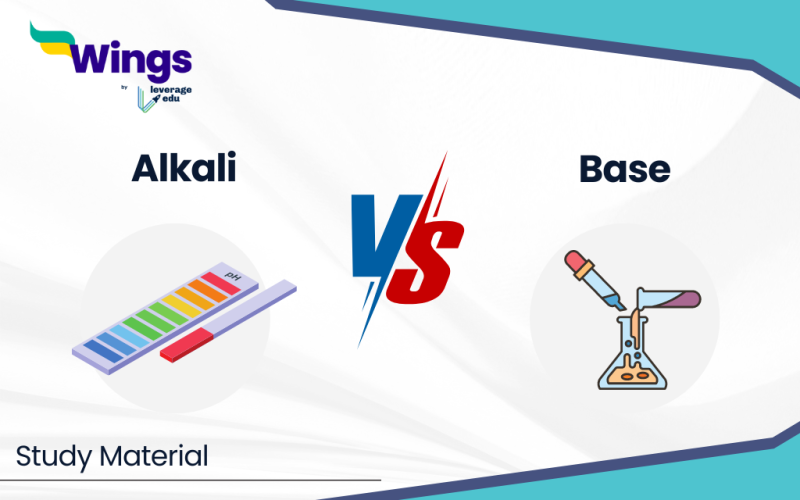The basic difference between alkali and base is that substances known as bases react with acids to neutralise them. Typically, they are metal hydroxides, metal carbonates, metal oxides, or metal hydrogen carbonates. Many bases don’t dissolve in water; they are insoluble. We refer to a base that dissolves in water as an alkali.
Sodium hydroxide is used in a wide range of products, including soap, detergents, and paper production. Two essentials are soap and detergent. You must have noticed how quickly they dissolve in water.
Can we thus conclude that every basic substance dissolves in water?
That’s not true, though. Not every fundamental material dissolves in water. Therefore, to prevent confusion, the fundamental compounds that dissolve in water are categorised separately. Let’s examine that unique class of fundamental chemicals and their differences.
Table of Contents [show]
What is Alkali?
An ionic salt of an earth metal or alkali metal is called an alkali. You may also refer to a base that dissolves in water as an alkali. A soluble base is present in a solution with a pH higher than 7. The soluble bases in water are referred to as alkalines.
Alkali soils are composed of soluble hydroxides of either alkali or alkaline earth metals.
Common examples of alkali salts include:
- Calcium hydroxide
- Potassium hydroxide
- Magnesium hydroxide
- Sodium hydroxide
Higher than 7.3 is the pH of alkaline salts. We find these soils in the surrounding nature because they are alkaline soils. Vegetables like cabbage fodder, or buffalo grass, are among the many plants that typically prefer somewhat basic soil. Soils with a pH range of 6 to 6.8 are generally considered to be somewhat acidic by plants, as alkaline soils can occasionally impact the vegetation.
The natural carbonate salt that is present in soda lakes, often referred to as alkali lakes, is altered by evaporation, which causes a saline or alkali lake to emerge.
A few alkali lakes are:
- Lake Magadi
- Lake Turkana
- Baldwin lake
- Summer lake
- Tramping lake
Also read: What is the Difference Between Gross Weight and Net Weight?
What is Base?
The base is most frequently defined to chemistry using the three equations; these definitions are as follows:
- Arrhenius bases
- Lewis bases
- Bronsted bases
These three bases equations define bases and conclude that bases are materials that react with acids to produce salt.
According to the scientific theory put forth by Arrhenius, bases are substances that dissolve or dissociate in aqueous solutions to produce Hydroxide ions (OH⁻).
In an acid-base reaction, hydroxide ions are created when an aqueous solution dissociates, and these ions combine with hydrogen ions to separate the acid from the water. Bases, like NaOH, are also commonly referred to as metal hydroxides.
These metal hydroxides also lose some characteristics, like:
- Have a bitter flavour
- Slick when touched
- It either modifies the pH indicator’s colour or turns the red litmus paper blue.
When the bases combine to form a solution, the pH rises above 7 and the activity of hydrogen ions is lower than in typical pure water. Alkali is a term used to describe soluble bases containing OH-negative ions. Oxides, which include metal oxides, hydroxides, and alkoxides, are blended bases of weak acids and bases that are basic.
Also Read: Difference Between Kinetic and Static Friction: Formulas, Real-Life Examples
The increase in hydronium ions in the acid concentration in water causes the acids and bases to diverge. Reducing concentration, on the other hand, is the basis. In an aqueous solution, neutralisation is the reaction of an acid and a base that produces a salt that separates the constituent ions. Furthermore, the salt turns or precipitates out of the solution if saturation with the solute happens in the specified aqua solution.
Properties of Bases:
- Electricity is produced when the molten base or aqueous solution separates into ions.
- Values of bases that are higher than 7 on a pH scale are considered standard.
- The bases have an unpleasant flavour.
Difference between Alkali and Base
The major difference between alkali and base is mentioned below:
| Alkali | Bases |
| Alkali can dissolve in water | Bases cannot get dissolved in water |
| All alkalis can be termed bases | When a reaction happens, it releases its negative ions and, accepts protons in return |
| All alkalis can be termed as bases | All bases cannot be alkali |
| One metal in the periodic table is an ionic compound in the alkali group | Any compound can be covalent of an ionic compound |
| Alkali metals, or alkali compounds, are soft and shiny | The base compounds are slippery when touched |
| Alkali metal or alkali compound defines strength by the concentration they form with the ionic salt | The strength of the base compounds is dependent on the concentration or density of Hydroxide ions |
| Examples- NaOH, Ca(OH)₂, KOH | Examples- NaOH, Al(OH)₃, KOH |
Uses of Alkali
Alkalis can be used for:
- Alkalis are used for environmental purposes
- Alkalis are also used for lake treatment
- Sewage Treatment is yet another use of alkali
- Industrial Applications
- Detergents
- Ceramic Products: Glass and Glazes
Uses of Base
A few of the uses of bases are:
- Bases are used in soap manufacturing, toothpaste, paper, rayon, etc.
- Bases are largely used in the baking industry.
- Used in bleaching powder and for cleaning purposes.
- It is used in the cleaning of sulphur dioxide.
- Also used in whitewashing.
- It is used in the detergent manufacturing industry.
Practice Questions
Ques 1. What will be the pH of alkaline substances?
- Less than 7
- Greater than 7
- Equals to 7
- None of the above
Answer: (B)
Solution: Just like any base, the alkali solution has a pH that is higher than 7.
Ques 2. Al(OH)3 is a/an
- Acid
- Base
- Alkali
- Mixture
Answer: (B)
Solution: Al(OH)3 is a base but not an alkali. Aluminium hydroxide (Al(OH)3) is not soluble in water.
Ques 3. Can acid be neutralized by alkali?
Answer:
Yes, alkali materials may neutralise acid with ease. When the OH- ion of the base and the H+ of the acid are balanced, a neutralisation reaction takes place, producing salt and water. The most typical illustration would be the HCl and NaOH neutralisation reaction.
| HCl aq + NaOH aq → NaCl aq + H2O l |
Here, H+ in HCL is balancing the OH- ion of NaOH for water and salt production (NaCl).
FAQs
The milk has a pH range of 6.5 to 6.7. Thus, milk has an acidic quality, yet it is quite close to pH 7. Consequently, the result on the litmus paper would be neutral to slightly acidic if the litmus paper was used.
Alkalis do indeed dissolve in water in general. However, barium carbonate can only be produced by interacting with an acidic aqueous solution.
HCL(g) is the chemical that is a proton donor.
RELATED POSTS
This was all about the “Difference between Alkali and Base”. For more such informative blogs, check out our Study Material Section, you can learn more about us by visiting our Indian exams page.
 One app for all your study abroad needs
One app for all your study abroad needs















 45,000+ students trusted us with their dreams. Take the first step today!
45,000+ students trusted us with their dreams. Take the first step today!
